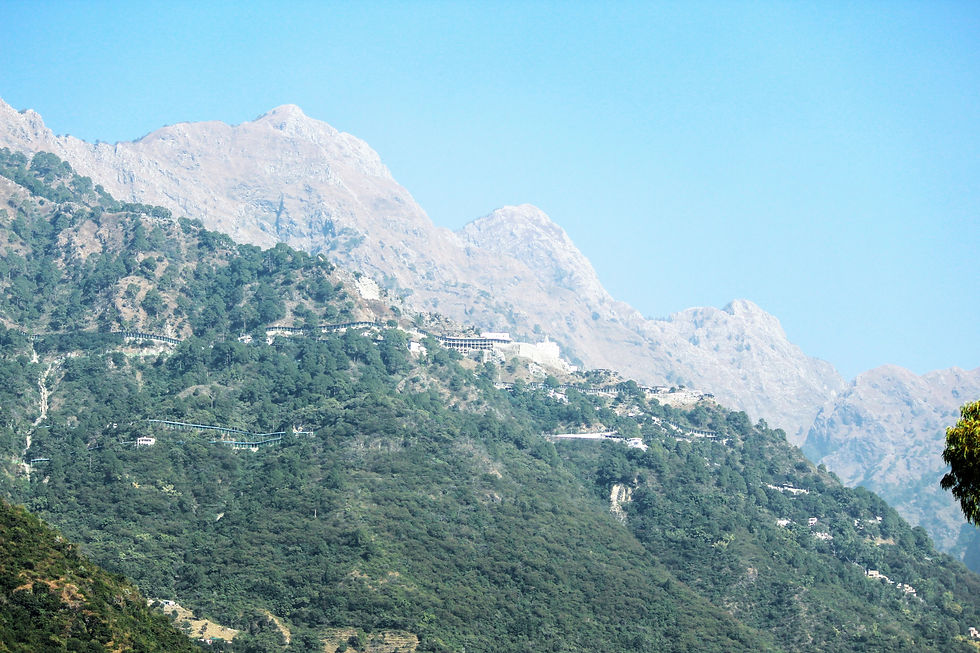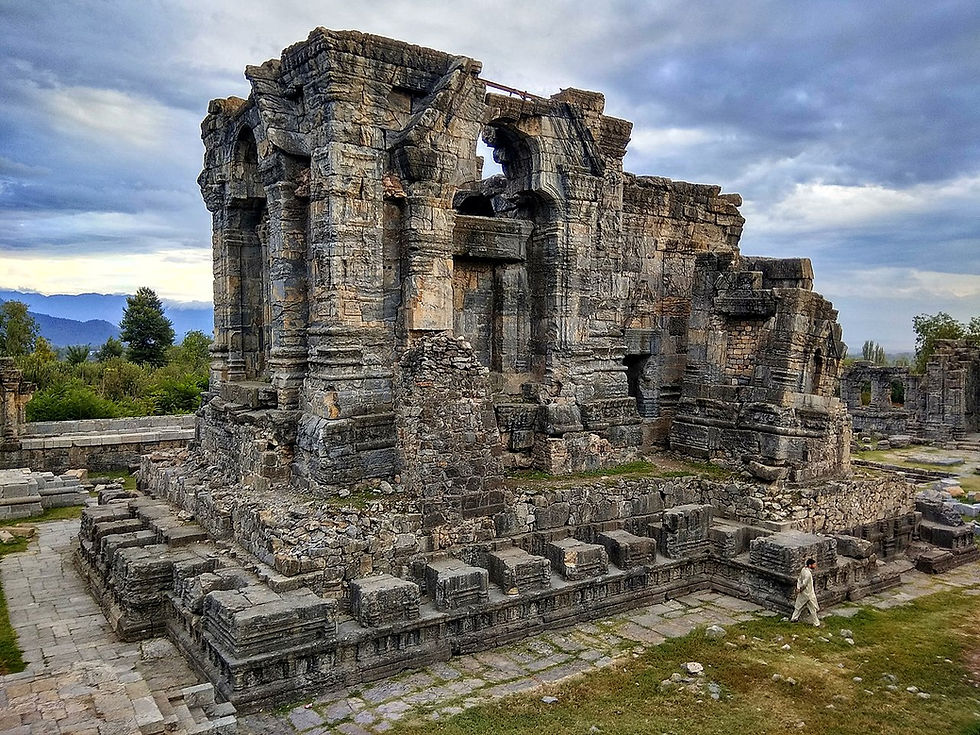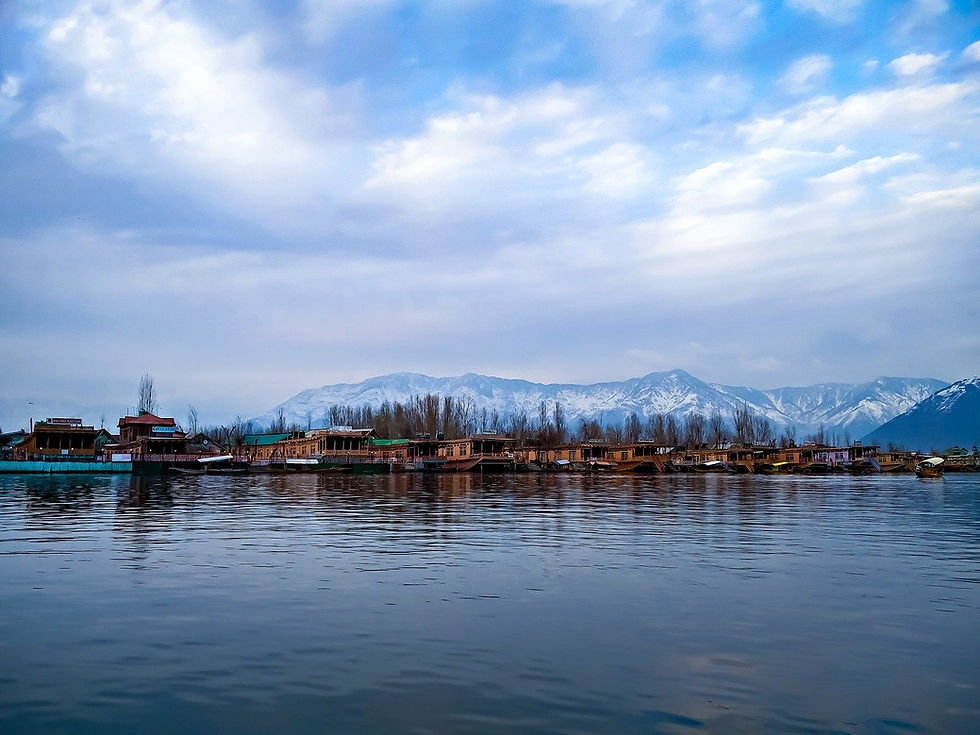Jammu and Kashmir
- Team Himalayan Journal

- Dec 18, 2020
- 9 min read
Jammu and Kashmir is an Indian administered region, located in the northern part of the Indian subcontinent, near the western mountain ranges. Earlier it was one of the major princely states of India. Jammu and Kashmir is surrounded by the Autonomous Region and Tibetan autonomous region of Sinkiang in Eastern (both China), South Himachal Pradesh and Punjab state, West Pakistan and northwestern Pakistan. Desai mountain is in the Pakistan occupied area of the west-central part of the state of Jammu and Kashmir. The capital of this state is Srinagar in summer and Jammu in winter.

Important Information
Capital: Jammu (Winter, Nov to April) and Srinagar (Summer, May to October)
Official language: Urdu, Kashmiri, Pahari, Ladakhi and Dogri
The establishment: January 26, 1947
Population: 12,267,013
Density: 290/ km 2 (750 / sq mi) / sq km
Area: 42,241 km 2 (16,309 mi 2 )
Geographic Coordinates: 33 ° 27 ′ 0 ″ north, 76 ° 14 ′ 24 ″ east
Temperature: 23 ° C (average)
Summer 23.4 - 43.0 ° C
Fall 4.3 - 26.2 ° C
District: 20
Largest city: Srinagar
Main tourist destination: Vaishno Devi, Amarnath, Dal Lake, Leh, Ladakh, Gulmarg, Kargil, Amar Mahal Palace, Nishat Bagh, Shalimar Bagh
Sex Ratio: 1000: 923 ♂ / ♀
Literacy: 54.46 %%
Female 41.82 %
Men 65.75 %
Lt Governor: Manoj Sina
Chief Minister: Empty

Geographical Location
The region of Jammu and Kashmir lies between 33 ° 27 ′ 0 ″ north, 76 ° 14 ′ 24 ″ east. Geographically, this can be divided into three regions. The hilly and semi-hilly plain known as Kandi Patti; Mountainous region comprising Shivalik hills; Kashmir valley mountains and Pir Panchal ranges
History
In the two authentic texts named Rajatarangini and Neelam Purana, it is found that the valley of Kashmir was once a very large lake. According to this legend, the Rishi Kashyapa drained water from here and turned it into a picturesque natural site, but geologists say that due to geological changes the lake's water flowed out of the mountains in Khadianyar, Baramulla and thus 'Earth' But the valley of Kashmir, called 'Paradise', came into existence. Emperor Ashoka propagated Buddhism in Kashmir in the third century BC. Later Kanishka deepened its roots. At the beginning of the sixth century, the Huns came to Kashmir.
Although the valley became independent again in 530, it was soon controlled by the Ujjain kingdom. After the fall of Vikramaditya dynasty, local rulers started ruling over Kashmir. A mixed form of Hindu and Buddhist cultures developed there.
Among the Hindu kings of Kashmir, Lalitaditya (697 to 738 AD) became the most famous king whose kingdom extended to Bengal in the east, Konkan in the south, Turkistan in the north-west, and Tibet in the north-east. Lalitaditya built many magnificent buildings.
Islam in Kashmir, the arrival took place in the 13th and 14th centuries. Zain-ul-Abedin (1420–70) became the most famous ruler among the Muslim rulers, who came to power in Kashmir when the Hindu king Singhdev fled after the Tataro's attack. Later the Chak rulers repulsed the army of Hyder Shah, son of Zain-ul-Awadin and ruled Kashmir till 1586. In 1586, Akbar conquered Kashmir. In 1752, Kashmir came out of the hands of the then weak Mughal emperor and passed into the hands of Ahmed Shah Abdali of Afghanistan. The Pathans ruled the Kashmir Valley for 67 years.

Article 370
Jammu and Kashmir also became independent with the end of British rule. Initially, its ruler Maharaja Harisingh decided that he would not be free to join India or Pakistan, but on October 20, 1947, the pro-Pakistan Azad Kashmir Army invaded the state, so that Maharaj Harisingh decided to annex the state to India. That merger letter was signed by Pandit Jawaharlal Nehru and Maharaj Harisingh on 26 October 1947. According to this merger letter- "The state will not retain its authority over only three subjects - defence, foreign affairs and communication - all else will be in control.
At that time the Government of India assured that the people of this state would by their own constitution determine the jurisdiction of the Indian Union over the state. Until the decision of the Government of India is approved by the State Legislative Assembly, the Constitution of India can only make interim arrangements with respect to the state. In this sequence, ' Article 370 ' was added to the Indian Constitution, which stated that the state provision related to Jammu and Kashmir is only temporary and not permanent.
Revocation of Article 370
In the year 2014, Bhartiya Janta Party came in power and Mr Narendra Modi became the Prime Minister of India. After five years the party included the revocation of Article 370 in their election manifesto and won the election by a majority.
In August 2019, the resolution to revoke article 370 was passed in both the houses of Parliament of India with reorganization act.
Geography of Jammu and Kashmir
The feature of narrow plains in the Jammu region is characterized by sediments deposited by the sediments flowing through the valleys and the interlinking of sandy alluvial plumes formed from loamy soil and loess (mud deposited by air) completely separated by erosive rock. Those belong to the Abhinutana (Pleistocene) era (ie 10 thousand to 16 million years old).

The rainfall here ranges from 380 to 500 mm yearly. During the summer season (June to September) when monsoon winds blow, there is precipitation in the form of strong but irregular showers. The interior area is completely devoid of trees and thorn bushes or thick grass is the main vegetation here.
The outer and inner zones are formed from the Himalayan lanes, ranging from 610 to 2134 meters in height. The outer enclosure is composed of sandstone, clay, punk and compact rocks. These areas, affected by the Himalayan folding activity and due to erosion, have become shaped like long mountain trunks and valleys (Doon).
The inner region is composed of more massive sedimentary rocks, including red sandstone of the Miocene age (about 53 to 237 million years ago). Whose twisting and erosion led to the formation of steeply sloping mountain wings and plateaus. The canopy of river valleys is sharp and terraced and alluvial soil like Udhampur and Poonch due to corruption. Basins have been formed. Rainfall increases with height and as the height increases, the lower shrublands take the place of pine and pine forests.
Valley of Kashmir
The valley of Kashmir has a deep and uneven basin, situated between the west end of the Pir Panjal and the vast Himalayan range, with an average height of 1,600 meters. It was once the foothills of Lake Karewa during the Abhinutana (Pleistocene) era. It is now filled with sediment and alluvial soil deposited by the Upper Jhelum River.
There is a remarkable diversity in soil and water conditions. Climate wise, it receives about 750 mm of annual rainfall. Some are caused by monsoon winds in summer and some by winds associated with low-pressure systems in winter. Snow and rain are often accompanied by snow.
The temperature changes a lot due to the height. The minimum average temperature in Srinagar is 2 degrees in January. And the maximum average temperature is 31 degrees in July.
Climate
More than 90 per cent of the state is mountainous. This region is divided into seven parts in terms of geographical shape that are attached to the structural components of West Himalayas.
From southwest to northeast these areas include the plains, lower hills, Pir Panjal mountain range, Kashmir valley, large Himalayan region, upper Indus valley and Karakoram mountain ranges.
In terms of climate, it has diversity ranging from the alpic (mountainous) climate of the northeast to subtropical in the southwest. Average annual rainfall ranges from 75 mm in the north to 1150 mm in the southeast.
Life
Due to the diversity of the landscape, there is also a huge diversity in the occupations of the people in this region. Due to the long-term tendency of people to migrate from Punjab, there are agricultural settlements in the plains and lakes.
Both the people and their culture are similar to neighbouring areas of Punjab and other lowlands of the west. Where the availability of alluvial soil and water for irrigation has made farming possible. As happened in the double valleys and lower valleys. The population is dependent on wheat and barley crops. This crop is harvested in the spring (Rabi) and rice and maize are the end of summer (Kharif) crops, as well as animal husbandry, and are dependent on maize farming, animal husbandry and forest produce.
For southern plains markets to produce milk and pure ghee, it is necessary to migrate to higher pastures in the spring. In the winter, the residents of the hills return to the lowlands and work in government forests or timber mills. Agricultural small settlements and villages abound. Towns like Jammu and Udhampur serve as market centres and administrative headquarters for rural and adjoining estates.
Language of Jammu and Kashmir
The Kashmiri language is influenced by Sanskrit and belongs to the painful branch of Indo-Aryan languages spoken by various hill tribes of Gilgit. Urdu, Dogri, Kashmiri, Ladakhi, Balti, Pahari, Punjabi, Gujri and Dadri languages are used by ordinary citizens.
Residents of the Valley of Kashmir speak Urdu or Kashmiri. The Kashmiri language belongs to the painful branch of the Indian Aryan class and is rich in folk songs and literature.
The economy of Jammu and Kashmir
Most of the people are engaged in agriculture for subsistence and rice, maize, wheat, barley, pulses, oilseeds and tobacco are grown on the steeper mountain slopes. Apples, pears, peaches, mulberry, walnuts and almonds are grown in large gardens in the valley of Kashmir.
The Valley of Kashmir is the only saffron producer for the Indian subcontinent. Sheep, goat, yoke and mules are reared and seasoned by Gujar and Gaddi nomads. The famous Pashmina of Kashmir is produced from goats grown here. Sericulture is also very popular.
Industrialization in Jammu and Kashmir
Handicrafts are a traditional industry here. Given the wide employment potential and expertise of handmade goods, the State Government is giving high priority to handicrafts. Paper in major handicraft products of KashmirOf pulp items, wood etching, carpets, shawls and embroidery items etc. A large amount of foreign exchange is earned from the handicrafts industry. There are 3.40 lakh workers in the handicrafts industry. The number of industries has increased.
A Rs 19 crore export promotion industrial park has been set up at Kartholi, Jammu. One such park is being built at Ompora, Budgam. Jammu has urban haats while similar haats are being built in Srinagar. A software technology park has been started at Ragreth, Srinagar at a cost of Rs 6.50 crore. Land reforms have been done.
The production of food grains has increased and after 1947 the volume of production of main export commodities, wood, fruits and dry fruits and handicrafts has increased a lot. Metal utensils, precision instruments, sporting goods (mainly cricket bats), furniture, embroidery, matches, resin and turpentine are the major industrial products of this state.
Agriculture in Jammu and Kashmir
About 80 per cent of the state's population is dependent on agriculture. Paddy, Wheat and maize are the main crops here. Barley, millet and jowar are grown in some parts. Gram is cultivated in Ladakh. The area of the orchards is 242 lakh hectares. The state produces fruits worth Rs 2000 crore per year, including Rs 120 crore for nut exports.
The state of Jammu and Kashmir has been declared as an agricultural export zone for apples and walnuts. From the beginning of the market intervention scheme, the quality of fruits is improved by ensuring proper grading. More than 25 lakh people get employment directly or directly from the horticulture sector.
Minerals in Jammu and Kashmir
In this field of mineral and fossil fuel resources are limited. Much of this is concentrated in the Jammu region. Small deposits of natural gas are found near Jammu. Bauxite and gypsum deposits are in Udhampur district. Other minerals include limestone, coal, zinc and copper.
Culture of Jammu and Kashmir (Including Ladakh)
Navreh word Sanskrit word made of " New Year" Navreh is celebrated as the Navchandra year in Kashmir. Shivaratri is also celebrated with reverence and devotion in Jammu and Kashmir. The four Muslim festivals celebrated in the state are Eid-ul-Fitr, Eid ul Zuha, Eid-e-Milad or Meeladunnabi and Meraj Alam. Muharram is also celebrated. The world-famous Gompa festival of Ladakh is celebrated in the month of June. The major attractive mask dance of the Hemis festival is. Statues of Kali are displayed extensively at the Spituk Buddhist Vihara in Leh every year in January. Apart from this, the peak of a winter festival is celebrated in Lohri and Ramban and the neighbouring villages, Singh Sankranti and Mela Pata in Bhaderwah in the month of August.
Jammu and Kashmir Tourism (Including Ladakh)
A lot of improvement has been made in the tourism facilities, although the possibilities are still to be utilized a lot. Tourism has a significant socio-economic impact on Ladakh. By 1970 it was generally cut off from outsiders. (500 tourists in 1974 and 16,018 in 1992).

Apart from historical and religious sites, tourist attractions are -
The ice skating centre in Gulmarg, which is located in the Pir Panjal Range south of Baramulla and Pahalgam, which is situated on the banks of the Lidder River.
The fountain of sulfur, which is famous for the early treatment of joint pain and arthritis, is located in Chumthang near Leh and Nobra and Puga (Chagathang) attracts tourists.
The Kashmir Valley is considered to be the paradise of the earth. Chashmeshehi waterfall, Shalimar Bagh, Dal Lake, Gulmarg, Pahalgam, Sonamarg and Amarnath mountain caves in the Kashmir Valley and Vaishno Devi Temple near Jammu, Patni Top and Buddhist Monasteries of Ladakh near Jammu are the major tourist centres of the state. Ladakh Mahotsav Sindhu Darshan is famous festivals.





Comments